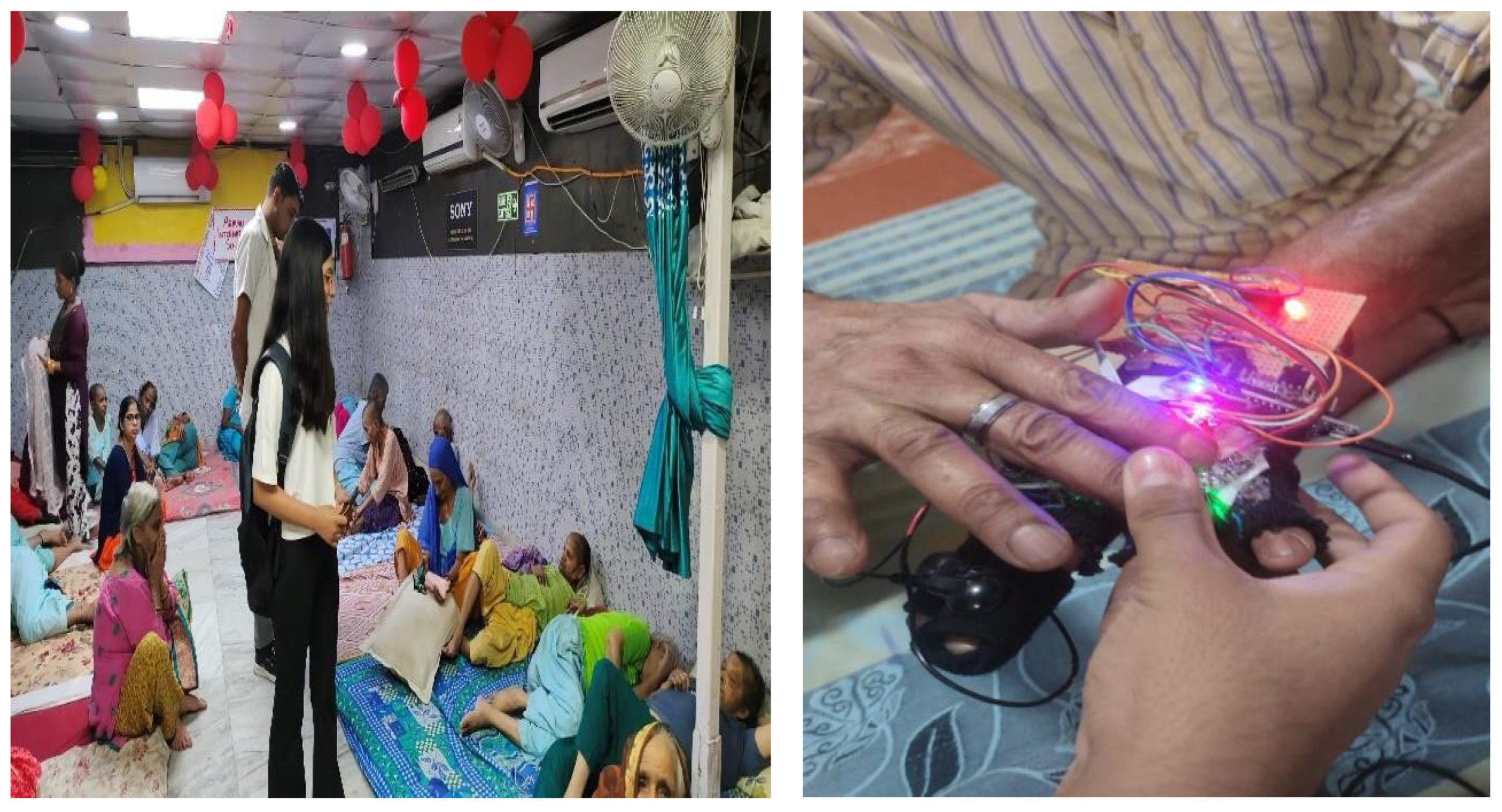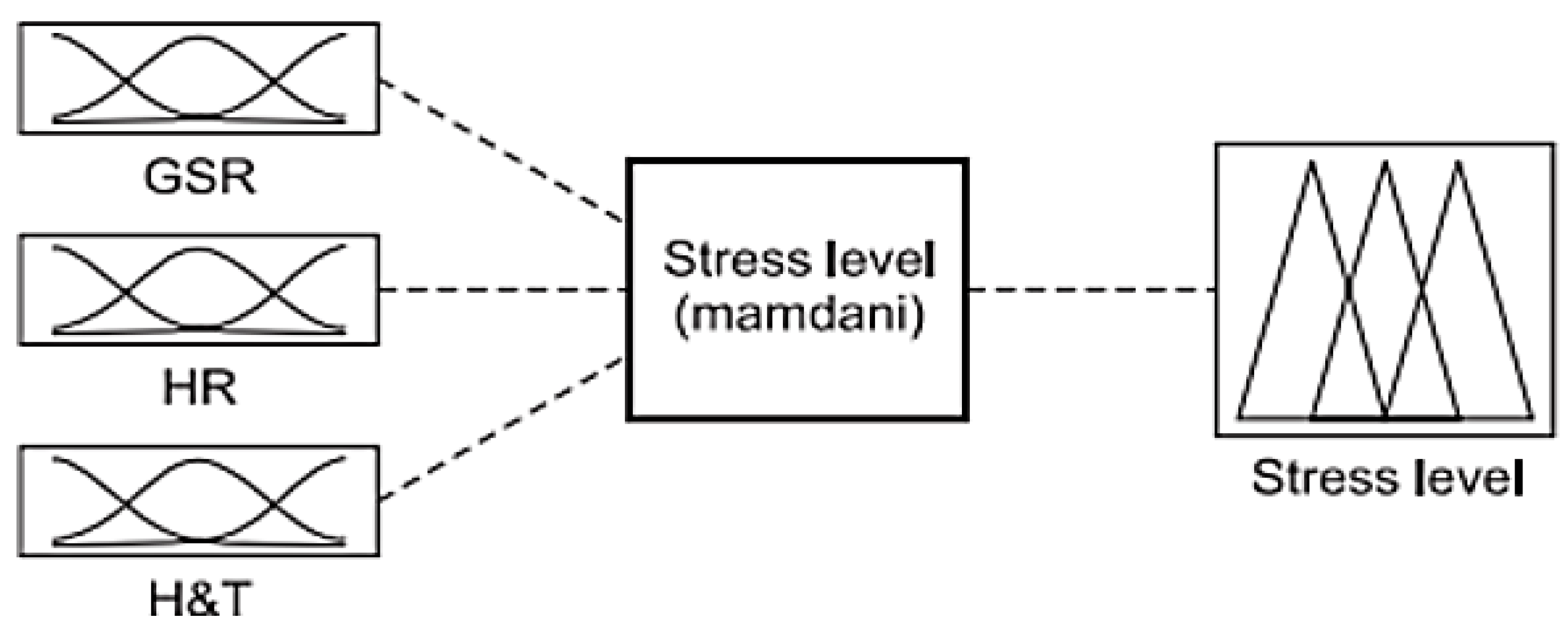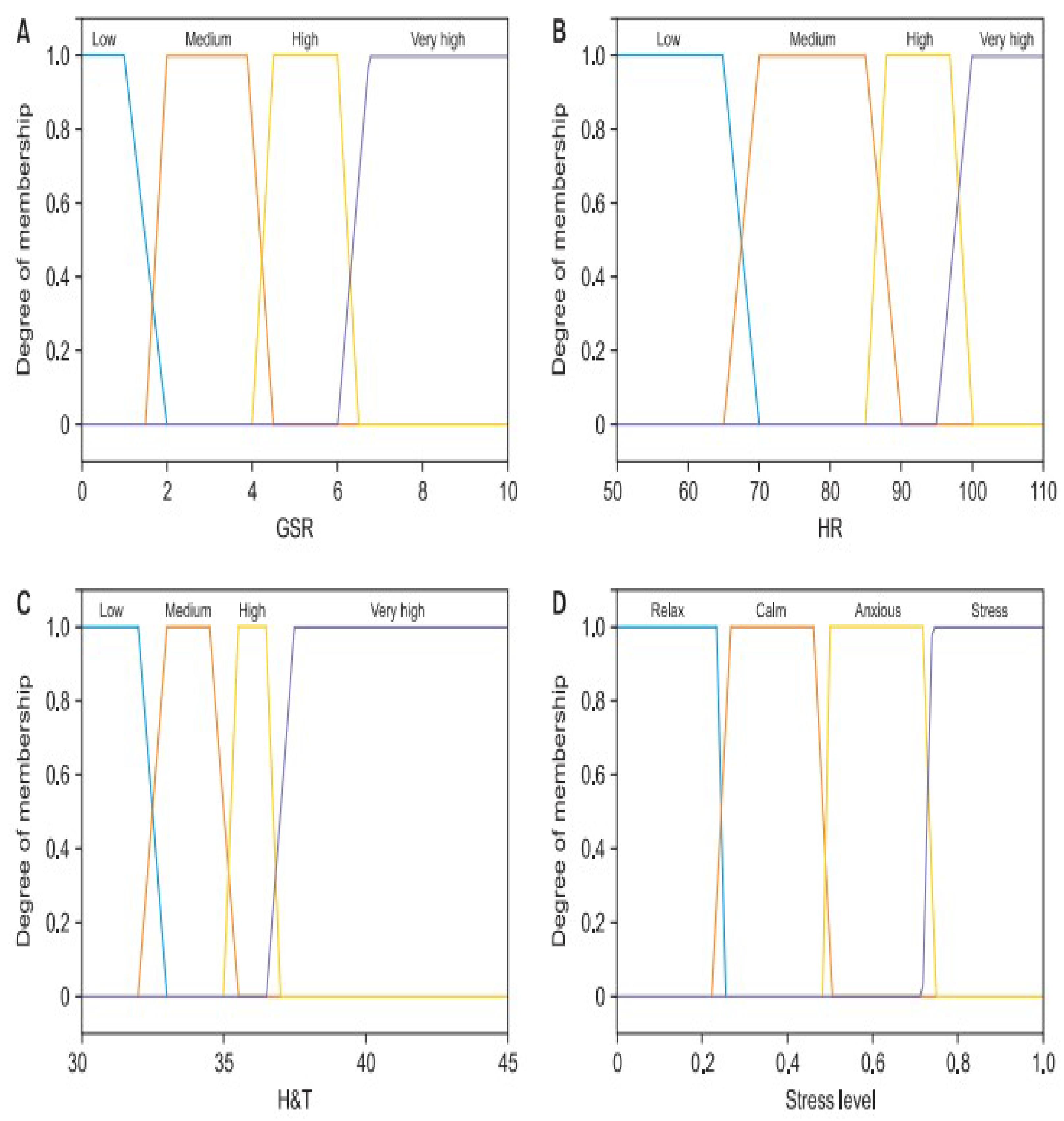Stress Detection Using Bio-Signal Processing: An Application of IoT and Machine Learning for Old Age Home Residents †
Abstract
1. Introduction
2. Proposed System
System Overview
- Smart glove: The system’s hardware centers on a cost-effective, user-friendly smart glove (refer to Figure 2a) which is equipped with sensors which continuously monitor essential physiological parameters related to stress. A microcontroller (ESP32) enables seamless data transmission from the glove to a local host interface (mobile phone in our case).
- Local host interface: The collected sensor data are displayed in real-time on an intuitive local host interface (refer to Figure 2b), allowing healthcare professionals and caregivers to monitor stress levels effectively. This interface also facilitates the manual recording of data in an Excel spreadsheet to ensure data completeness, accuracy, and analysis.
3. Methodology Adopted
3.1. Data Acquisition
3.2. Stress Classification Using Fuzzy Logic
3.3. Machine Learning-Based Stress Prediction
3.4. Model Testing and Validation
4. Results and Discussion
4.1. Model Performance
4.2. Strengths, Challenges, and Future Scope of the System
5. Conclusions
Author Contributions
Funding
Institutional Review Board Statement
Informed Consent Statement
Data Availability Statement
Acknowledgments
Conflicts of Interest
References
- Feng, G.; Xu, X.; Lei, J. Tracking perceived stress, anxiety, and depression in daily life: A double-downward spiral process. Front. Psychol. 2023, 14, 1114332. [Google Scholar] [CrossRef]
- Cattaneo, A.; Anacker, C.; Daskalakis, N.; Riva, M.A. Impact of stress exposure on mental and physical health across the life span: Molecular mechanisms, neurobiological abnormalities, and novel pathways for intervention. Psychoneuroendocrinology 2023, 153, 106142. [Google Scholar] [CrossRef]
- Nater, U.M. Recent developments in stress and anxiety research. J. Neural Transm. 2021, 128, 1265–1267. [Google Scholar] [CrossRef] [PubMed]
- Muñoz, S.; Iglesias, C.Á.; Mayora, O.; Osmani, V. Prediction of stress levels in the workplace using surrounding stress. Inf. Process. Manag. 2022, 59, 103064. [Google Scholar] [CrossRef]
- Baloh, R.W. Stress, anxiety and depression. In Exercise and the Brain; Springer: Berlin/Heidelberg, Germany, 2022; pp. 129–146. [Google Scholar] [CrossRef]
- Sarmiento, L.F.; da Cunha, P.L.; Tabares, S.; Tafet, G.; Gouveia, A., Jr. Decision-making understress: A psychological and neurobiological integrative model. Brain Behav. Immun. Health 2024, 38, 100766. [Google Scholar] [CrossRef]
- Palamarchuk, I.S.; Vaillancourt, T. Mental resilience and coping with stress: A comprehensive, multi-level model of cognitive processing, decision making, and behavior. Front. Behav. Neurosci. 2021, 15, 719674. [Google Scholar] [CrossRef]
- Can, Y.S.; Arnrich, B.; Ersoy, C. Stress detection in daily life scenarios using smartphones and wearable sensors: A survey. J. Biomed. Inform. 2019, 92, 103139. [Google Scholar] [CrossRef]
- Van Der Kolk, B.A. Trauma and memory. Psychiatry Clin. Neurosci. 1998, 52, S52–S64. [Google Scholar] [CrossRef]
- The Most Stressed Country in Europe. Available online: https://www.internationalaccountingbulletin.com/news/revealed-the-most-stressed-countries-in-europe/?cf-view (accessed on 13 February 2024).
- Wolfson, J.A.; Garcia, T.; Leung, C.W. Food insecurity is associated with depression, anxiety, and stress: Evidence from the early days of the COVID-19 pandemic in the United States. Health Equity 2021, 5, 64–71. [Google Scholar] [CrossRef]
- Cohen, S.; Williamson, G.M. Stress and infectious disease in humans. Psychol. Bull. 1991, 109, 5. [Google Scholar] [CrossRef]
- O’Connor, D.B.; Thayer, J.F.; Vedhara, K. Stress and Health: A Review of Psychobiological Processes. Annu. Rev. Psychol. 2021, 72, 663–688. [Google Scholar] [CrossRef] [PubMed]
- Montgomery, R.M.; Gouvea, M.A.V.M. Impact of Chronic Stress on Physical and Mental Health: A Detailed Analysis. Preprints 2024. [Google Scholar] [CrossRef]
- Iqbal, S.; Howse, J.; Banu, S.; Lateef, A.; Khan, S.; Barlas, Z.; Moon, S.; Moukaddam, N.; Shah, A.A. The Effects of Stress on Health. Psychiatr. Ann. 2024, 54, e272–e276. [Google Scholar] [CrossRef]
- Nargund, V.H. Effects of psychological stress on male fertility. Nat. Rev. Urol. 2015, 12, 373–382. [Google Scholar] [CrossRef]
- Ilacqua, A.; Izzo, G.; Emerenziani, G.P.; Baldari, C.; Aversa, A. Lifestyle and fertility: The influence of stress and quality of life on male fertility. Reprod. Biol. Endocrinol. 2018, 16, 115. [Google Scholar] [CrossRef]
- Palomba, S.; Daolio, J.; Romeo, S.; Battaglia, F.A.; Marci, R.; La Sala, G.B. Lifestyle and fertility: The influence of stress and quality of life on female fertility. Reprod. Biol. Endocrinol. 2018, 16, 113. [Google Scholar] [CrossRef]
- Valsamakis, G.; Chrousos, G.; Mastorakos, G. Stress, female reproduction, and pregnancy. Psychoneuroendocrinology 2019, 100, 48–57. [Google Scholar] [CrossRef]
- Chang, Y.M.; El-Zaatari, M.; Kao, J.Y. Does stress induce bowel dysfunction? Expert Rev. Gastroenterol. Hepatol. 2014, 8, 583–585. [Google Scholar] [CrossRef]
- Moore, R.C.; Straus, E.; Campbell, L.M. Stress, mental health, and aging. In Handbook of Mental Health and Aging, 3rd ed.; Academic Press: Cambridge, MA, USA, 2020; pp. 37–58. [Google Scholar] [CrossRef]
- Jalali, A.; Ziapour, A.; Karimi, Z.; Rezaei, M.; Emami, B.; Kalhori, R.P.; Khosravi, F.; Sameni, J.S.; Kazeminia, M. Global prevalence of depression, anxiety, and stress in the elderly population: A systematic review and meta-analysis. BMC Geriatr. 2024, 24, 809. [Google Scholar] [CrossRef]
- Steinert, A.; Haesner, M.; Steinhagen-Thiessen, E. Stress in older adults–causes, consequences and coping strategies. Gerontologist 2016, 56 (Suppl. 3), 725. [Google Scholar] [CrossRef]
- Eckerling, A.; Ricon-Becker, I.; Sorski, L.; Sandbank, E.; Ben-Eliyahu, S. Stress and cancer: Mechanisms, significance, and future directions. Nat. Rev. Cancer 2021, 21, 767–785. [Google Scholar] [CrossRef] [PubMed]
- Al-Atawi, A.A.; Alyahyan, S.; Alatawi, M.N.; Sadad, T.; Manzoor, T.; Farooq-i-Azam, M.; Khan, Z.H. Stress monitoring using machine learning, IoT and wearable sensors. Sensors 2023, 23, 8875. [Google Scholar] [CrossRef] [PubMed]
- Talaat, F.M.; El-Balka, R.M. Stress monitoring using wearable sensors: IoT techniques in medical field. Neural Comput. Appl. 2023, 35, 18571–18584. [Google Scholar] [CrossRef]
- Vos, G.; Trinh, K.; Sarnyai, Z.; Azghadi, M.R. Generalizable machine learning for stress monitoring from wearable devices: A systematic literature review. Int. J. Med. Inform. 2023, 173, 105026. [Google Scholar] [CrossRef]
- Almadhor, A.; Sampedro, G.A.; Abisado, M.; Abbas, S.; Kim, Y.-J.; Khan, M.A.; Baili, J.; Cha, J.-H. Wrist-based electrodermal activity monitoring for stress detection using federated learning. Sensors 2023, 23, 3984. [Google Scholar] [CrossRef]
- Bolpagni, M.; Pardini, S.; Dianti, M.; Gabrielli, S. Personalized Stress Detection Using Biosignals from Wearables: A Scoping Review. Sensors 2024, 24, 3221. [Google Scholar] [CrossRef]
- Basjaruddin, N.C.; Syahbarudin, F.; Sutjiredjeki, E. Measurement Device for Stress Level and Vital Sign Based on Sensor Fusion. Healthc Inform. Res. 2021, 27, 11–18. [Google Scholar] [CrossRef]





| Stress Level | GSR (μS) | Heart Rate (bpm) | Temperature (°C) |
|---|---|---|---|
| Relax | <2 | 60–70 | 36–37 |
| Calm | 2–4 | 70–90 | 35–36 |
| Anxious | 4–6 | 90–100 | 33–35 |
| Stress | >6 | >100 | <33 |
| GSR | Body Temperature | Heart Rate | |||
|---|---|---|---|---|---|
| Low | Medium | High | Very High | ||
| Low | Low | Relax | Anxious | Anxious | Low |
| Medium | Relax | Calm | Anxious | Anxious | |
| High | Relax | Calm | Calm | Anxious | |
| Very High | Relax | Relax | Calm | Anxious | |
| Medium | Low | Anxious | Anxious | Anxious | Medium |
| Medium | Calm | Calm | Anxious | Anxious | |
| High | Calm | Calm | Calm | Anxious | |
| Very high | Relax | Calm | Calm | Relax | |
| High | Low | Anxious | Calm | Anxious | High |
| Medium | Anxious | Anxious | Anxious | Anxious | |
| High | Calm | Calm | Anxious | Anxious | |
| Very high | Calm | Calm | Anxious | Stress | |
| Very High | Low | Anxious | Anxious | Stress | Anxious |
| Medium | Anxious | Anxious | Anxious | Stress | |
| High | Anxious | Calm | Anxious | Stress | |
| Very high | Calm | Calm | Anxious | Stress | |
| Anxious | Calm | Relax | Stress | |
|---|---|---|---|---|
| Relax | 0 | 5 | 1 | 0 |
| Calm | 2 | 156 | 0 | 0 |
| Anxious | 91 | 5 | 0 | 0 |
| Stress | 1 | 0 | 0 | 2 |
| ML Models | Accuracy | Precision | Recall | F1 Score |
|---|---|---|---|---|
| Logistic Regression | 75.67% | 74.17% | 75.67% | 74.63% |
| SVM | 90.87% | 89.44% | 90.87% | 89.76% |
| Random Forest | 95.06% | 95.22% | 95.06% | 94.38% |
| Sl No | GSR (μS) | Temperature (°C) | Heart Rate (bpm) | Predicted Stress Level (From ML Model) | Validated Stress Level (From Old Age Home Residents) |
|---|---|---|---|---|---|
| 1 | 3.11 | 32.32 | 77 | Calm | Calm |
| 2 | 5.67 | 34.18 | 71 | Anxious | Anxious |
| 3 | 3.81 | 37.13 | 67 | Relax | Relax |
| 4 | 4.85 | 35.44 | 75 | Calm | Calm |
| 5 | 3.48 | 35.67 | 76 | Calm | Calm |
| 6 | 3.14 | 32.45 | 70 | Calm | Anxious |
| 7 | 4.79 | 35.53 | 69 | Calm | Calm |
| 8 | 4.42 | 37.25 | 85 | Stress | Stress |
| 9 | 3.31 | 32.58 | 69 | Calm | Calm |
| 10 | 3.09 | 35.44 | 78 | Calm | Calm |
| 11 | 4.9 | 35.59 | 70 | Calm | Calm |
| 12 | 3.44 | 33.11 | 67 | Calm | Calm |
| 13 | 4.66 | 35.55 | 73 | Calm | Calm |
| 14 | 2.96 | 33.38 | 85 | Anxious | Anxious |
| 15 | 3.64 | 37.34 | 69 | Calm | Calm |
| 16 | 2.4 | 33.17 | 77 | Calm | Calm |
| 17 | 4.55 | 36.97 | 76 | Calm | Calm |
| 18 | 2.2 | 35.4 | 78 | Calm | Calm |
| 19 | 4.31 | 34.56 | 67 | Anxious | Stress |
| 20 | 5.93 | 36.36 | 70 | Calm | Calm |
| 21 | 2.28 | 36.32 | 70 | Calm | Calm |
| 22 | 2.1 | 32.38 | 80 | Anxious | Anxious |
| 23 | 5 | 37.1 | 71 | Calm | Calm |
| 24 | 5.75 | 31.99 | 74 | Calm | Calm |
| 25 | 3.7 | 34.66 | 77 | Calm | Calm |
| 26 | 2.25 | 34.7 | 83 | Anxious | Anxious |
| 27 | 2.82 | 35.9 | 78 | Calm | Calm |
| 28 | 2.34 | 33.22 | 78 | Calm | Calm |
| 29 | 5.8 | 34.2 | 80 | Anxious | Anxious |
| 30 | 3.08 | 33.89 | 65 | Calm | Calm |
| 31 | 4.9 | 34.85 | 69 | Anxious | Anxious |
| 32 | 2.78 | 34 | 71 | Calm | Calm |
| 33 | 4.52 | 31.33 | 76 | Calm | Calm |
| 34 | 5.72 | 34.28 | 73 | Anxious | Calm |
| 35 | 4.12 | 31.91 | 85 | Anxious | Anxious |
Disclaimer/Publisher’s Note: The statements, opinions and data contained in all publications are solely those of the individual author(s) and contributor(s) and not of MDPI and/or the editor(s). MDPI and/or the editor(s) disclaim responsibility for any injury to people or property resulting from any ideas, methods, instructions or products referred to in the content. |
© 2025 by the authors. Licensee MDPI, Basel, Switzerland. This article is an open access article distributed under the terms and conditions of the Creative Commons Attribution (CC BY) license (https://creativecommons.org/licenses/by/4.0/).
Share and Cite
Ahuja, A.K.; Mishra, B.P.; Shankar, C.; Dubey, T.P. Stress Detection Using Bio-Signal Processing: An Application of IoT and Machine Learning for Old Age Home Residents. Eng. Proc. 2024, 81, 12. https://doi.org/10.3390/engproc2024081012
Ahuja AK, Mishra BP, Shankar C, Dubey TP. Stress Detection Using Bio-Signal Processing: An Application of IoT and Machine Learning for Old Age Home Residents. Engineering Proceedings. 2024; 81(1):12. https://doi.org/10.3390/engproc2024081012
Chicago/Turabian StyleAhuja, Amit Kumar, Bajarang Prasad Mishra, Chandra Shankar, and Tanishk Prakash Dubey. 2024. "Stress Detection Using Bio-Signal Processing: An Application of IoT and Machine Learning for Old Age Home Residents" Engineering Proceedings 81, no. 1: 12. https://doi.org/10.3390/engproc2024081012
APA StyleAhuja, A. K., Mishra, B. P., Shankar, C., & Dubey, T. P. (2024). Stress Detection Using Bio-Signal Processing: An Application of IoT and Machine Learning for Old Age Home Residents. Engineering Proceedings, 81(1), 12. https://doi.org/10.3390/engproc2024081012





